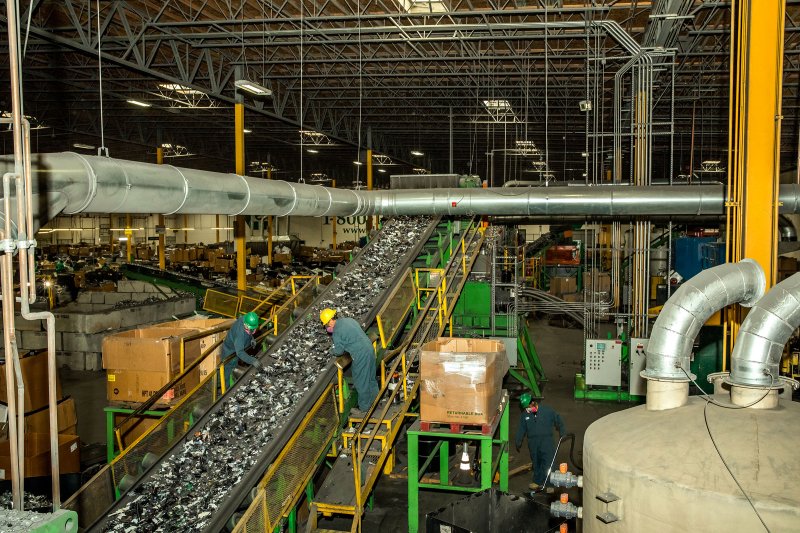You know that the blue bin is for items that can be recycled, like glass bottles, aluminum cans, plastic tubs and cardboard boxes. But did you know that there some items that aren’t allowed to go into the blue bin that can still be recycled?
See what popular everyday things can get recycled outside of the blue bin.
Electronic Waste

Electronic waste is any old, broken or unwanted electronics that you want to get rid of. It could be a smartphone with a cracked screen. It could become a video game console that doesn’t work anymore. It could be a blender that has been sitting untouched in your kitchen cupboard for well over a decade. It can be any electronic device that’s no longer being used.
The problem with electronic waste is that you can’t put it into the garbage bin or in the blue recycling bin. Electronic devices often contain potentially harmful materials like lead and cadmium, which can contaminate the waste in landfills and recycling facilities. These materials also pose health risks to workers unknowingly handling the waste in these environments.
E-waste needs careful attention. It has to be separated from other types of waste, and it has to be brought to a specialized recycling facility. If you have a lot of electronic items that you want to get rid of, you should visit the website CanadaIron.com to see how this scrap metal yard handles electronic waste recycling in a safe and efficient way. You can rest assured that your items are managed properly when you drop them off at the yard.
These are some examples of items that you can bring in for electronic waste recycling:
- Computers
- Tablets
- Keyboards
- Televisions
- DVD Players
- Radios
- Video game consoles
- Modems
- Phones
- Printers
- Ink Cartridges
Speaking of printers, you also can’t throw the inkjet and toner cartridges for your printers into the recycling bin. The local waste disposal services suggest that you place them into the garbage bin when they’re used up. However, you can keep them out of landfills and recycle them.
The reason why inkjet and toner cartridges can’t go into the blue bin is that they can spill ink all over the other products in the bin, complicating the separating and recycling process. They’re still recyclable. The cartridges are made of plastic and can be melted down and reused. They just need to be handled carefully and separately to ensure that the leftover ink doesn’t contaminate other products.
Where do you recycle them? Many office supply stores take old cartridges and recycle them free of charge. Before you drop them off, you should make sure that the cartridges are empty. You can wait until your printer tells you that the cartridges are in need of replacing.
When you’re ready to bring them to the office supply store, put the cartridges in a protective container, like a resealable plastic bag, to prevent any mess. You don’t want to get ink everywhere. It would be a shame that you had to throw out a ruined bag after trying to make an environmentally savvy decision.
Batteries

Batteries are lumped in the category of HHW (Household Hazardous Waste). Much like electronic waste, batteries contain hazardous ingredients like lead, cadmium and lithium. If these chemicals leak, they can contaminate the surrounding waste and environment. They could get into the soil and groundwater.
One of the other problems with batteries is that they could short circuit if they’re mishandled. This makes them very dangerous to toss into garbage bins or blue bins. They could start a fire at the landfill or recycling plant.
You can still recycle them, but they have to be separated from other types of waste. There are countless places that accept batteries for specialized recycling: community centres, libraries, office supply stores and municipal Household Hazardous Waste drop-off centres.
One of the best tips for recycling old batteries is to put pieces of electrical tape over the positive and negative ends to prevent short circuits and fires. You should also put them in a secure container and line them up, instead of letting them jumble in a pile.
If you want to be less wasteful, you can purchase rechargeable batteries and a charger. Replacing your single-use batteries with rechargeable ones will make you use less, and in turn, throw out less.
Carpeting

You may have noticed that the local waste disposal service classifies carpeting as an oversized item — this is an item that doesn’t fit into the Garbage Bin. It can be taken away with the garbage as long as it is properly rolled, tied up and placed near the garbage bins on curbside pick up days. It must be less than 4 feet long and weigh less than 44 pounds to get taken away to the landfill.
Carpeting is treated like garbage, but it’s actually not good to throw in the landfill. It can be recycled into new carpet products. It can also be turned into other useful items like automobile parts, industrial flooring and parking barriers. Even carpet underlay can be recycled into packaging material. So, you can either recycle your carpeting or send it to a landfill where it will take over 50 years to decompose.
How do you do it? You can call your local carpet removal and recycling services to help you get rid of it. Your community recycling centre may accept carpeting, as long as you transport it there. You will likely pay a disposal fee based on the amount that you bring in.
If you want to remove the carpet yourself, you should slowly pull up the carpet and yank out the staples using a pair of pliers. To make it more manageable, you can cut the carpeting into smaller pieces, using a utility knife to slice it down the back.
If the carpeting is in good condition, you can also donate it to some charitable organizations. You will need to clean it thoroughly beforehand.
Recycling can be accomplished beyond the blue bin. You just have to know where to go. Now that you know how these popular items are recycled, you can keep them out of landfills and get rid of them properly.


